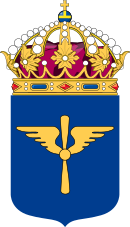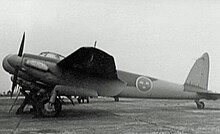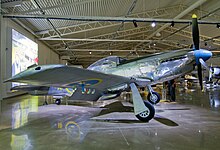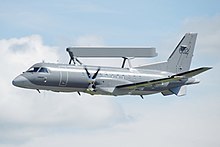Swedish Air Force: Difference between revisions
m →Aircraft: fix origin of JAS 39D |
Rescuing 4 sources and tagging 0 as dead. #IABot (v1.5) |
||
| Line 284: | Line 284: | ||
Defense Minister Sten Tolgfors responded to the Russian purchase of [[Mistral-class amphibious assault ship]]s by saying that the Swedish Air Force would need "sea targeting capabilities".<ref>{{Citation|title=Sweden may change its defense forces to counter Russia’s Mistral purchase |url=http://www.acus.org/natosource/sweden-may-change-its-defense-forces-counter-russias-mistral-purchase |newspaper=NATO source |publisher=ACUS |deadurl=yes |archiveurl=https://web.archive.org/web/20130314041138/http://www.acus.org/natosource/sweden-may-change-its-defense-forces-counter-russias-mistral-purchase |archivedate=2013-03-14 |df= }} </ref> |
Defense Minister Sten Tolgfors responded to the Russian purchase of [[Mistral-class amphibious assault ship]]s by saying that the Swedish Air Force would need "sea targeting capabilities".<ref>{{Citation|title=Sweden may change its defense forces to counter Russia’s Mistral purchase |url=http://www.acus.org/natosource/sweden-may-change-its-defense-forces-counter-russias-mistral-purchase |newspaper=NATO source |publisher=ACUS |deadurl=yes |archiveurl=https://web.archive.org/web/20130314041138/http://www.acus.org/natosource/sweden-may-change-its-defense-forces-counter-russias-mistral-purchase |archivedate=2013-03-14 |df= }} </ref> |
||
In 2013, the USMC introduced Swedish helicopter units to the [[forward air control]] airborne mission profile for better air-ground coordination.<ref>{{Citation | title = MAWTS-1 Marines introduce FAC(A) to Swedish Air Force | first = Tatum | last = Vayavananda | date = August 28, 2013 | publisher = Marines | url = http://www.marforeur.marines.mil/News/NewsArticleDisplay/tabid/7617/Article/148808/mwats-1-marines-introduce-faca-to-swedish-air-force.aspx | place = [[United States of America|US]] | newspaper = Mar for Eur |
In 2013, the USMC introduced Swedish helicopter units to the [[forward air control]] airborne mission profile for better air-ground coordination.<ref>{{Citation | title = MAWTS-1 Marines introduce FAC(A) to Swedish Air Force | first = Tatum | last = Vayavananda | date = August 28, 2013 | publisher = Marines | url = http://www.marforeur.marines.mil/News/NewsArticleDisplay/tabid/7617/Article/148808/mwats-1-marines-introduce-faca-to-swedish-air-force.aspx | place = [[United States of America|US]] | newspaper = Mar for Eur | deadurl = yes | archiveurl = https://archive.is/20130830033904/http://www.marforeur.marines.mil/News/NewsArticleDisplay/tabid/7617/Article/148808/mwats-1-marines-introduce-faca-to-swedish-air-force.aspx | archivedate = August 30, 2013 | df = }} </ref> In the same year, 60 further modified E class Gripens were ordered with the first plane to join the Air force in 2018.<ref>{{cite web |url= http://rod.se/klartecken-att-k%C3%B6pa-60-nya-jas-plan/ | newspaper =Riksdag & Departement | title = Klartecken ätt köpa nya JAS plan | trans-title = The go-ahead to buy new fighter, attack & reconnaissance planes | language = sv | place = SE |publisher= Rod |accessdate= 8 October 2014}}</ref> In April 2014, the Swedish government proposed another 10 fighters making the total order 70 planes.<ref name = DN>{{cite web | language = sv |url= http://www.dn.se/nyheter/politik/sa-vill-regeringen-starka-forsvaret/ |title= Så vill regeringen stärka försvaret |work= DN | place = SE | trans-title = So the government wants to strengthen the defense |accessdate= 8 October 2014}}</ref> |
||
===Saab JAS 39 Gripen === |
===Saab JAS 39 Gripen === |
||
| Line 315: | Line 315: | ||
{{commons|Swedish Air Force}} |
{{commons|Swedish Air Force}} |
||
{{commons|Swedish Air Force Historical Flight, SwAFHF}} |
{{commons|Swedish Air Force Historical Flight, SwAFHF}} |
||
* [http://www.forsvarsmakten.se/en/our-organisation/our-forces/the-swedish-air-force/ Swedish Air Force – Official site] |
* [https://web.archive.org/web/20141022031004/http://www.forsvarsmakten.se/en/our-organisation/our-forces/the-swedish-air-force/ Swedish Air Force – Official site] |
||
* [http://www.swafhf.se/ Swedish Air Force Historical Flight, SwAFHF] |
* [http://www.swafhf.se/ Swedish Air Force Historical Flight, SwAFHF] |
||
* [http://www.mil.se/historia/1900.html History of the Swedish Air Force] {{Sv icon}} |
* [https://web.archive.org/web/20091005081425/http://www.mil.se/historia/1900.html History of the Swedish Air Force] {{Sv icon}} |
||
* [http://www.ww2wings.com/wings/sweden/swedenmain.shtml Information on Swedish military aviation] |
* [http://www.ww2wings.com/wings/sweden/swedenmain.shtml Information on Swedish military aviation] |
||
* [http://www.sunnersberg.com/ Sunneberg – Information on Swedish aircraft] {{Sv icon}} |
* [https://web.archive.org/web/20080302100507/http://www.sunnersberg.com/ Sunneberg – Information on Swedish aircraft] {{Sv icon}} |
||
{{Swedish Armed Forces}} |
{{Swedish Armed Forces}} |
||
Revision as of 02:56, 4 September 2017
| Swedish Air Force | |
|---|---|
 Swedish Air Force Coat of arms | |
| Founded | July 1, 1926 |
| Country | |
| Part of | Swedish Armed Forces |
| March | Flygvapnets Defileringsmarsch (March of the Swedish Air Force), by Helge Damberg |
| Equipment | 238 aircraft/helicopters |
| Engagements | Winter War[1] Congo Crisis Afghanistan War 2011 military intervention in Libya |
| Commanders | |
| Chief of Air Force | Major General Mats Helgesson |
| Insignia | |
| Roundels |   |
| Aircraft flown | |
| Electronic warfare | S 102B Korpen, S 100 Argus |
| Fighter | JAS 39 Gripen |
| Helicopter | A109, NH90, UH-60M |
| Trainer | Saab 105 |
| Transport | C-130H Hercules, Saab 340, Gulfstream IV, Gulfstream 550 |
The Swedish Air Force (Template:Lang-sv) is the air force branch of the Swedish Armed Forces.
History
The Swedish Air Force was created on July 1, 1926 when the aircraft units of the Army and Navy were merged. Because of the escalating international tension during the 1930s the Air Force was reorganized and expanded from four to seven squadrons. When World War II broke out in 1939 further expansion was initiated and this substantial expansion was not finished until the end of the war. Although Sweden never entered the war, a large air force was considered necessary to ward off the threat of invasion and to resist pressure through military threats from the great powers. By 1945 the Swedish Air Force had over 800 combat-ready aircraft, including 15 fighter divisions.
A major problem for the Swedish Air Force during World War II was the lack of fuel. Sweden was surrounded by countries at war and could not rely on imported oil. Instead domestic oil shales were heated to produce the needed petrol.[2]
Expansion during the Cold War


The Swedish Air Force underwent a rapid modernization from 1945. It was no longer politically acceptable to equip it with second-rate models. Instead, the Air Staff purchased the best it could find from abroad, e.g. P-51D Mustangs, De Havilland Mosquito NF.19 night fighters and de Havilland Vampires, and supported the development of top performance domestic models. When the Saab 29 Tunnan fighter was introduced around 1950, Sweden suddenly had planes that were equal to the best of the Royal Air Force, the Soviet Union's VVS, and the U.S. Air Force.
During the 1950s the air force started to build road bases after an idea taken from Germany. Built under the BASE 60 distributed airfield scheme,[3] the bases were ordinary highways constructed in such a way that they could also serve as landing strips. In the early eighties road number 44 was rebuilt to contain four short runways (17 x 800 metres). Along the road a large number of turn-around-sites for rearming and refueling were built. These short runways are still used today for training, landing and taking off with Gripen and Hercules as preparation for international operations under adverse conditions.[4]
During the Cold War large amounts of money (including all that had been reserved for Swedish nuclear weapons) were spent on the Swedish Air Force and domestic airplane production. In 1957 Sweden had the world's fourth most powerful air force,[5] with about 1000 modern planes in front-line service.[6] During the 1950s, it introduced fighters such as the Saab J 29 Tunnan, Saab A 32 Lansen and Saab J 35 Draken.
In June 1952 the Swedish Air Force lost two aircraft on Cold War operations, in what became known as the Catalina affair. A signals intelligence Douglas DC-3 was intercepted by Soviet MiG-15s over the Baltic, and shot down with the loss of three aircrew and five civilian technicians. A PBY Catalina rescue seaplane was then also downed, the five-man crew being rescued from the sea by a freighter.
War service
The Swedish Air Force has seen involvement at some level in three wars, the Finno-Soviet Winter War in 1939–40, in which volunteers took part, the Congo Crisis, 1961–64, and in the 2011 Libyan civil war.
Finland 1940
When the Soviet Union attacked Finland in November 1939, Sweden came to its neighbour's assistance in most ways short of joining the war outright. A Swedish volunteer infantry brigade and a volunteer air squadron fought in northern Finland in January till March 1940. The squadron was designated F 19 and consisted of 12 Gloster Gladiator fighters and four Hawker Hart dive-bombers.
Congo 1961–1964
The Swedish Air Force saw combat as part of the United Nations peace-keeping mission ONUC during the Congo Crisis in 1961 to 1964. It established a separate air wing, F 22, equipped with a dozen semi-obsolete Saab 29 Tunnans, which performed well under the rugged conditions in central Africa. The secessionist adversaries possessed only a small number of aircraft with poor combat capabilities, e.g. Fouga Magister trainers.
1990s – restructuring
The end of the Cold War saw the Swedish Armed Forces undergo a massive restructuring process. During that time, several air bases were deemed unnecessary and closed. In 1994 the air force had over 400 fighters, by 2005 the number had sunk to fewer than 150.
Libya 2011
On March 29, 2011, the Swedish prime minister announced that eight Saab JAS 39 Gripens would support the UN-mandated no-fly zone over Libya.[7] The announcement responded to a NATO request for assistance. The Swedish fighters were limited to supporting the no-fly zone and were not authorized to engage in ground attack sorties. The deployment was approved by the Swedish Riksdag on April 1, 2011 and the first jets departed for Libya on April 2. A C-130 Hercules accompanied the fighters for mid-air refueling.[8]
Inventory
Aircraft



| Aircraft | Origin | Type | Variant | In service | Notes | |
|---|---|---|---|---|---|---|
| Combat aircraft | ||||||
| JAS 39 Gripen | Sweden | multirole | JAS 39C/E | 72 | 60 E variants on order[9] | |
| AWACS | ||||||
| Saab 340 | Sweden | AEW&C | 4[9] | equipped with the Erieye radar | ||
| Reconnaissance | ||||||
| Gulfstream IV | United States | SIGINT | 2[9] | |||
| Tanker | ||||||
| KC-130 Hercules | United States | aerial refueling / transport | KC-130H | 1[9] | ||
| Transport | ||||||
| Saab 340 | Sweden | utility transport | 1[9] | |||
| C-130 Hercules | United States | transport | C-130H | 4[9] | ||
| Defence Helicopter Wing | ||||||
| Sikorsky UH-60 | United States | utility | UH-60M | 15[9] | ||
| NHIndustries NH90 | European union | utility / transport | TTH | 14 | 4 on order[9] | |
| AgustaWestland AW109 | Italy | trainer / light utility | 20[9] | eight are designed for operations at sea[10] | ||
| Trainer aircraft | ||||||
| Saab 105 | Sweden | jet trainer | 43[9] | |||
| JAS 39 Gripen | Sweden | conversion trainer | JAS 39D | 23[9] | ||
| UAV | ||||||
| Elbit Skylark | Israel | surveillance | ()[11] | |||
| AAI RQ-7 Shadow | United States | surveillance | ()[12] | |||
Weapons
Organization
Fighter units
There are three wings of fighters:
- Skaraborg Air Force Wing (F 7 Såtenäs)
- Blekinge Air Force Wing (F 17 Kallinge)
- Norrbotten Air Force Wing (F 21 Luleå)
Helicopter units

The aviation units that were formerly under the Swedish Army ("Arméflyget") and the Swedish Navy ("Marinflyget") have been merged with the helicopter units of the Air Force to form the single Helicopter Wing (Helikopterflottiljen, abbreviated Hkpflj) for the entire Armed Forces. The wing has been placed under the authority of the Air Force and consists of:
- 1st Helicopter Detachment (1 Helikopterskvadronen, abbreviated 1 Hkpskv)
- 2nd Helicopter Detachment (2 Helikopterskvadronen, abbreviated 2 Hkpskv)
- 3rd Helicopter Detachment (3 Helikopterskvadronen, abbreviated 3 Hkpskv)
Aircraft
The Air Force has deployed the Gripen in service. Designated Saab JAS 39 Gripen— JAS standing for Jakt (Air-to-air), Attack (Air-to-surface) and Spaning (Reconnaissance), and means every Gripen can fulfill all three mission types—, it is a modern multi-role fighter designed to replace the Draken and Viggen. Capabilities of Gripen include a short runway requirement, advanced data link equipment, and canard delta design with lateral instability and fly-by-wire.[14]
Sweden originally ordered 204 Gripen aircraft.[15] Out of these 80 remain in service in the Air Force today and an additional 28 are leased to the Czech and Hungarian Air Force (14 each), with an option to acquire them when the lease period expires. Furthermore, 12 aircraft were sold to the Royal Thai Air Force.[16]



Future
This section needs to be updated. (January 2016) |
The Swedish Air Force is being adapted to new future tasks. With the collapse of the only military threat, the Soviet Union, and the end of the Cold War, the Swedish government has cut the Swedish armed forces budget, including the Air Force and its fighters. Today about 80 Gripen C/D fighters remains in service. Some orders have been made on the helicopter side and about 40 new units will join the air force in the coming years. Saab has also joined the primarily French project for the unmanned future stealth plane Dassault nEUROn.
In 2008 and 2010, the Swedish armed forces wanted to retire even more fighters and close air bases to relocate money to other branches. However, because of negative response from the public and pressure from the Swedish government, no cuts happened As of 2011[update].[17][18][19][20]
Defense Minister Sten Tolgfors responded to the Russian purchase of Mistral-class amphibious assault ships by saying that the Swedish Air Force would need "sea targeting capabilities".[21]
In 2013, the USMC introduced Swedish helicopter units to the forward air control airborne mission profile for better air-ground coordination.[22] In the same year, 60 further modified E class Gripens were ordered with the first plane to join the Air force in 2018.[23] In April 2014, the Swedish government proposed another 10 fighters making the total order 70 planes.[24]
Saab JAS 39 Gripen
Today the Swedish Air Force main fighter is the Saab JAS 39 Gripen, in the C/D versions. By 2015 97 fighters were active with about 30 of these being updated from the A version.[25]
The heavily modernised E version will replace the current fleet of Gripen Cs. The new aircraft includes a new Active Electronically Scanned Array (AESA) radar, and is powered by the General Electric F414G. It carries more fuel and weapons. The upgrade also includes new weapon systems like the Meteor missile system.[26] In 2013, Saab signed an agreement with the Swedish Defence Materiel Administration for 60 new Gripen in the E version. The first aircraft is to join the Swedish Air Force by 2018.[27] There are also plans to buy further 10 aircraft.[24]
Military transport aircraft
Today the Swedish Air Force’s only transport plane is the C-130 Hercules (TP-84). The plane was bought from the United States in the 1960s and has been updated several times. By 2020 the current version will not be able to fly because of new restrictions to civilian air space. The Swedish Defence Materiel Administration has been tasked to update the aircraft so they can remain in service to 2030. There are also plans to buy new aircraft by 2024 to replace the current fleet.[28]
Trainers
Sweden uses the Saab 105 as the primary jet-trainer. About 40 planes are today operational. Designed in the 1960s the aircraft is starting to show its old age and talks about replacing these aircraft has begun. One plan is to replace the Saab 105 system with the future Boeing T-X program, a joint trainer program developed by Boeing and Saab.[29] Other option are the Brazil Embraer Super Tucano and the Swiss PC-21.[30]
See also
- Chief of Air Force (Sweden)
- Royal Swedish Academy of War Sciences
- List of air forces
- List of military aircraft of Sweden
- Swedish Air Force Museum
- Swedish Air Force Historic Flight
People
References
- ^ "I luftstrid över Lappland" (in Swedish). Svenskt Militärhistoriskt Bibliotek. Retrieved 2012-12-11.
- ^ Prien, Charles (1976). "Survey of Oil-Shale Research in the Last Three Decades". In Yen, T.F.; Chilingarian, George V. (eds.). Oil shale edited by Teh Fu Yen and George V. Chilingarian. Amsterdam: Elsevier. p. 236. ISBN 0444414088.
{{cite book}}:|access-date=requires|url=(help) - ^ Martin, Guy (2005–2009). "The Draken: One of Sweden's finest fighters". Aircraft Information. Retrieved 26 May 2010.
- ^ "Viggen Showcase – Grästorp, Sweden". History. Saab. 2007-06-16. Retrieved 2011-03-29.
- ^ "The growth of the Air Force". Flygvapenmuseum. 2010-05-01. Retrieved 2011-03-29.
- ^ Flygvapnet, SE: SFHM, archived from the original (PDF) on 2012-03-18
{{citation}}: Unknown parameter|deadurl=ignored (|url-status=suggested) (help) - ^ "Sweden plans to join Libya no-fly zone with fighter jets, but no ground attacks" (hosted news). Google. Associated Press. 29 March 2011. Retrieved 30 March 2011.
- ^ "Swedish Gripen Planes Headed to Libya". The Local. 2 April 2011. Retrieved 2 April 2011.
- ^ a b c d e f g h i j k "World Air Forces 2017". Flightglobal Insight. 2017. Retrieved 7 June 2017.
- ^ "Helikopter 15" (in Swedish). Försvarets materielverk. Retrieved 2011-09-17.
{{cite web}}: Unknown parameter|trans_title=ignored (|trans-title=suggested) (help) - ^ "SUAV systemet Falken", Materiel och teknik Flyg (in Swedish), Försvarets materielverk, archived from the original on 2011-07-05
{{citation}}: Unknown parameter|deadurl=ignored (|url-status=suggested) (help); Unknown parameter|trans_title=ignored (|trans-title=suggested) (help) - ^ "UAV 3 Ornen", Materiel och teknik (in Swedish), Försvarets materielverk, archived from the original on 2011-11-12
{{citation}}: Unknown parameter|deadurl=ignored (|url-status=suggested) (help) - ^ "Julgran markerar slutet för en epok", Förband och förmågor (in Swedish), Försvarsmakten, archived from the original on 2013-04-18
{{citation}}: Unknown parameter|dead-url=ignored (|url-status=suggested) (help) - ^ "AirSpace". Flightglobal. Retrieved 2015-05-20.
- ^ "Swedish Air Force". The Aviationist. Retrieved 8 October 2014.
- ^ "Gripen Operational in the Royal Thai Air Force". 8 July 2011. Retrieved 28 August 2012.
- ^ SVT, SE, archived from the original on 2009-03-23
{{citation}}: Unknown parameter|deadurl=ignored (|url-status=suggested) (help) - ^ SVT, SE, archived from the original on 2009-03-23
{{citation}}: Unknown parameter|deadurl=ignored (|url-status=suggested) (help) - ^ "Nyheter". DN. SE. Retrieved 2015-05-20.
- ^ TT (2010-03-06). "Försvaret föreslår nya nedläggningar" [The defense proposes new closures] (in Swedish). SE: SMP. Retrieved 2011-03-29.
- ^ "Sweden may change its defense forces to counter Russia's Mistral purchase", NATO source, ACUS, archived from the original on 2013-03-14
{{citation}}: Unknown parameter|deadurl=ignored (|url-status=suggested) (help) - ^ Vayavananda, Tatum (August 28, 2013), "MAWTS-1 Marines introduce FAC(A) to Swedish Air Force", Mar for Eur, US: Marines, archived from the original on August 30, 2013
{{citation}}: Unknown parameter|deadurl=ignored (|url-status=suggested) (help) - ^ "Klartecken ätt köpa nya JAS plan" [The go-ahead to buy new fighter, attack & reconnaissance planes]. Riksdag & Departement (in Swedish). SE: Rod. Retrieved 8 October 2014.
- ^ a b "Så vill regeringen stärka försvaret" [So the government wants to strengthen the defense]. DN (in Swedish). SE. Retrieved 8 October 2014.
- ^ Gummesson, Jonas. "Vart tredje JAS-plan taget ur drift". SvD (in Swedish). SE. Retrieved 5 August 2016.
{{cite web}}: Unknown parameter|trans_title=ignored (|trans-title=suggested) (help) - ^ "Gripen E Multirole Fighter Aircraft". Air force technology. Retrieved 5 August 2016.
- ^ "Saab signs agreement for the next generation fighter aircraft Gripen E and receives development order". Saab. Retrieved 5 August 2016.
- ^ "Flyg jättarna som kan lyfta svenska Försvaret", SvD (in Swedish)
{{citation}}: Unknown parameter|trans_title=ignored (|trans-title=suggested) (help). - ^ Augustsson, Tomas. "Saabs nya skolplan för avancerat för Sverige". svd.se. Retrieved 22 May 2017.
- ^ "Operativ effekt är inte detsamma som den billigaste lösningen". wisemanswisdoms.blogspot.se. Retrieved 22 May 2017.

